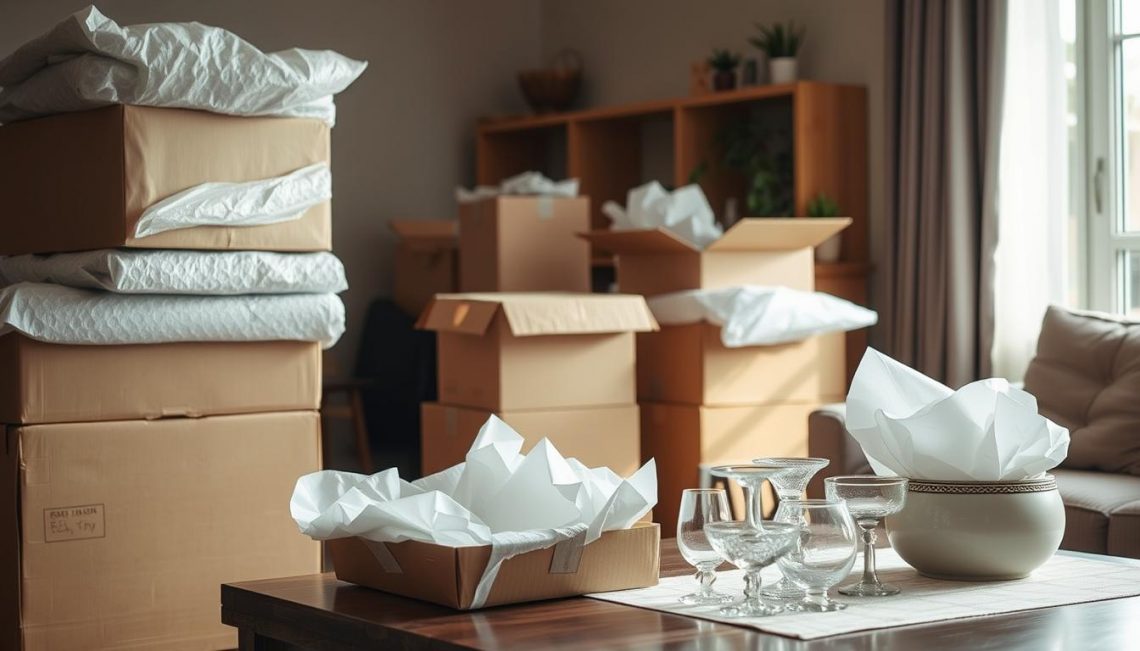Moving fragile items can be tough, but with the right steps, you can do it safely. It’s important to know how to pack these items carefully. This guide will help you understand how to handle delicate goods and choose the best packing materials.
By planning your move well, you can keep your valuables safe. This way, you’ll also lower the chance of damage when moving them.
Understanding Your Fragile Items
Knowing what fragile items you have at home is key to keeping them safe when you move. Every home has delicate objects that need extra care. By identifying these items, you can protect them better.
Identifying Fragile Items in Your Home
Start by sorting out what’s sturdy and what’s not. Look out for items that break easily. These include:
- Glassware
- Pottery
- Electronics
- Mirrors
- Artwork
Listing your items is important. It helps you not miss anything important when moving. Knowing what you have helps you pack and protect it right.
Common Types of Fragile Items
Many types of fragile items are found in homes. Some examples are:
- Glass items
- Ceramics and porcelain
- Antiques and collectibles
- Musical instruments
Each type needs special care when packing. Knowing how to pack them right helps keep them safe during the move.
Assessing the Value of Your Fragile Items
It’s important to know the value of your fragile items. This helps you make smart choices. Consider:
- Current market value
- Sentimental worth
- Condition of the items
Keep records of your items’ value. This makes it easier to get insurance for them. Having these records helps if something gets damaged during the move.

| Item Type | Common Characteristics | Packing Recommendations |
|---|---|---|
| Glassware | Thin, easily breakable | Bubble wrap and sturdy boxes |
| Pottery | Often heavy, fragile edges | Pack with cushioning materials |
| Electronics | Delicate circuitry | Original boxes or foam padding |
| Artwork | Vulnerable to scratches and moisture | Use protective frames and sealed containers |
How to Safely Pack and Move Fragile Items
Packing fragile items needs careful planning and the right supplies. You can protect your valuables by using the right materials and techniques. Here’s a list of essential supplies and a step-by-step guide for packing your delicate items.
Choosing the Right Packing Supplies
Choosing the right packing materials is key to protecting fragile items. Here are some must-have supplies:
- Sturdy boxes: Use different sizes for various items, making sure they can hold weight.
- Bubble wrap: Great for wrapping delicate items, it cushions them against impacts.
- Packing paper: Wrap dishes and other breakables with it to avoid scratching.
- Foam peanuts: Fill gaps in boxes to keep items from moving during transport.
- Tape: Use high-quality packing tape to keep boxes closed and contents safe.
Label boxes clearly to avoid mishandling. Use transparent tape to keep labels visible during the move.
Step-by-Step Packing Techniques
Using effective packing techniques is crucial for protecting fragile items. Follow this guide to pack your delicate belongings:
- Wrap each item individually with bubble wrap or packing paper for extra protection.
- Secure each piece with tape, making sure all seams are tight.
- For glassware, use dividers to keep each item separate and cushioned.
- Place heavier items at the bottom of boxes, then add lighter items on top.
- Fill empty spaces with foam peanuts or crumpled packing paper to prevent movement.
Properly loading a moving vehicle is also important. Make sure boxed fragile items are loaded upright and well secured. Follow these best practices to ensure your fragile items arrive safely at your new home.

| Packing Material | Purpose | Best Use |
|---|---|---|
| Sturdy Boxes | Support for items | Dishes, glassware, framed art |
| Bubble Wrap | Cushioning | Delicate figurines, electronics |
| Packing Paper | Surface protection | Plates, ceramics |
| Foam Peanuts | Filling gaps | Various items |
| Tape | Securing boxes | All packed items |
Tips for a Smooth Moving Process
Planning and organization are key to a smooth move. Start by making a detailed moving inventory. This list will help you remember to pack fragile items. It also ensures nothing gets left behind.
Creating a timeline for packing and moving day can reduce stress. It helps you stay organized and focused throughout the process.
For delicate items, consider hiring professional movers. They know how to handle fragile items safely. They have the right tools and materials to protect your valuables.
Make sure to tell your movers which items need extra care. This way, they can handle them correctly.
Choose a vehicle that fits your delicate items well. Vehicles with padded interiors or special compartments are best. By following these tips, you can have a successful and stress-free move.



0 Comments